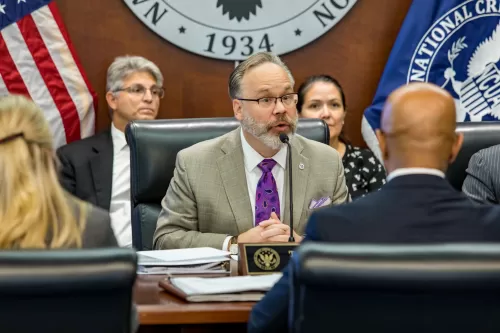NCUA Chairman Todd M. Harper asks questions during the October 2022 NCUA Board Meeting at the NCUA’s headquarters in Alexandria, Virginia.
As Prepared for Delivery on October 20, 2022
Thank you, Anthony, for your informative briefing on the Central Liquidity Facility, or CLF for short. Since becoming CLF President, you and your team have worked hard to bolster and improve the facility’s processes, operations, and structures. Thank you for your diligent efforts.
And, Board Member Hood, thank you for being a strong advocate for creating a separate CLF office with a dedicated, full-time president focused solely on the CLF’s management. Thank you, too, Vice Chairman Hauptman, for supporting these improvements to the CLF’s operations.
With more than $29 billion in borrowing capacity, $1.2 billion in total assets, and nearly 4,000 regular and agent members, the CLF is a vital source of emergency liquidity within the credit union system. However, the pending expiration of the temporary CLF enhancements authorized by Congress at the start of the COVID-19 pandemic remains a very real concern.
We already know of several credit unions experiencing liquidity issues in recent months, including some with more than $1 billion in assets. And, with ongoing inflationary pressures and likely continued interest rate increases, there is the potential for strong headwinds slowing the economy and increasing stress on households and financial institutions. Those headwinds could soon result in even more credit unions encountering liquidity issues. So, the CLF must stay alert and ready to support the credit union system and the Share Insurance Fund.
For the CLF to work best, we need a flexible agent member option. By permitting corporate credit unions to become agent members for groups of credit unions, rather than requiring them to join for their entire membership, the CLF becomes a more affordable and attractive option for corporate credit unions to participate in. Without that agent membership, credit unions with less than $250 million in assets will be much less likely to have access to a federal liquidity backstop when they need it.
And, without legislation to extend the temporary CLF enhancement provisions, there will be a $9.7 billion reduction in reserve liquidity for the credit union system at the end of 2022. Likewise, the 3,648 credit unions with less than $250 million in assets that now have access to the CLF through their corporate credit unions will lose a liquidity lifeline. These credit unions include most of our nation’s 509 minority depository institutions.
We know through the painful lessons of the financial crisis more than a decade ago how quickly liquidity can dry up during periods of economic and financial stress. While we are grateful to Congress for allowing the CLF enhancements of the last few years, there is a real need to keep in place the ability of corporate credit unions to serve as an CLF agent for a subset of their members. That authority will allow us to provide emergency liquidity quickly when needed.
Now, let me turn to some questions. First, Anthony, how can the Central Liquidity Facility best achieve its full potential?
Thank you for that response. It is helpful for stakeholders to understand the full potential that the CLF has to support the credit union system.
My second question is about the growing signs of interest rate and liquidity risk. Would you highlight some of the trends you are seeing?
That’s a good point, Anthony. I would also add the trends we are seeing illustrate why the CLF’s role as a liquidity backstop for credit unions is so essential.
My next question deals with why credit unions should join the CLF as a regular member. Why is it important for credit unions to have a relationship with the CLF? And, how do you plan to increase awareness about the benefits of joining the CLF?
Thank you, Anthony. My final question is about the pending expiration of the agent membership authority amendments adopted by Congress at the start of the COVID-19 pandemic. Would you discuss the consequences of that authority expiring?
Thank you for laying out those consequences clearly and let me add one more point. Before a storm starts, we need to ensure the liquidity pipelines of the credit union system remain in good working order. That is why my fellow Board members and I continue to call on Congress to make permanent the CLF agent member enhancement. I thank Vice Chairman Hauptman and Board Member Hood for their steadfast efforts in support of this critical legislative goal.
That concludes my remarks. I now recognize Vice Chairman Hauptman.



